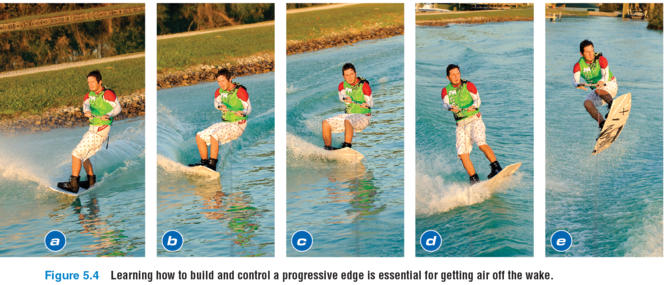Tips for edging through a wake
This is an excerpt from Water Skiing and Wakeboarding by Ben Favret.
Edging Through the Wake
If you are a surfer, then you know about waves. A wake is similar to a wave in the ocean. Surfers need to understand the dynamics of the ocean, tides, and winds to know how waves are created and when and where to surf. Similarly, wakeboarders need to understand the dynamics of a wake to get air. As a boat travels across a flat lake, it displaces water, which creates a wake. The heavier the boat, the bigger the wake because more energy is pushing the water. As a result, there is more force, or energy, to propel you higher. You want to use the energy of the wake to push you up into the air rather than try to jump off the top of the wake. By learning this skill correctly, you use less energy on the takeoff and have more control and strength for more complex moves once you are in the air.
Getting “big air” begins by learning how to create energy as you approach the wake. Progressive tipping for edging is the most important skill for every wakeboarder to master. Start by gradually edging, or tipping, the board first on the heel side (see figure 5.4). Edging the board into and up the wake creates the energy needed for pushing against the force of the wake. As you hit the wake, you release that energy by simply extending your knees, thus pushing the board against the energy of the wake. The key is to increase your edge pressure, or tip angle, as you get closer to the top of the wake. When done correctly, you get pushed into the air proportional to the energy you create with your edge up the wake. Creating the correct body position, alignment, and stacking against the boat as you approach the wake both heel side and toe side takes time to master and is a skill that you should work on consistently.

The following steps break edging down move by move:
- Edge out beside the boat 10 to 15 feet (3 to 4.6 m) and make a slow, smooth tip of the board, letting the board move under the rope until you feel the boat start to pull you back toward the wake.
- Maintain the tipped edge of the board as you approach the wake, and gently increase the tip edge. You will pick up speed as you tip the edge of the board. Think about continuously turning the board in an arc toward the wake while showing more of the base of your board to the boat.
- Continue to build up your edge tipping and increase your knee flexion and counterrotation away from the boat to the top of the wake. You will feel an increased pull in your hands as you climb the wake. Be sure to keep the handle down at your waist. Many riders mistakenly think that to get height, they must edge as hard as they can, as long as they can, and generate speed into the wake. There is no doubt that a hard, fast edge, or tip, will develop a lot of speed and give you distance, but it won't give you any height. Such an approach uses too much force early in the arc toward the wake and does not generate lift from the wake.
- As you ride up the wake on edge, extend your knees! Stay in dynamic balance in relation to the slope of the wake and the pull of the rope, typically slightly away from the boat. Keep the handle by your waist, and move your hips toward the handle. Extend your chest and head up. In this position you can resist the force of the wake pushing up on you by pushing down against it. Imagine that you are trying to break the board in half at the crest of the wake.
- The release of the energy you created with a proper tipping edge into the wake and your leg extension will result in what most describe as a pop or lift off the wake, similar to a double bounce on a trampoline as the wake's force reacts to your downward energy.
- Keep your eyes open to spot the landing, and then absorb it with your knees and ankles to quickly establish edge control and continue out on edge away from the boat.
A common error when trying a progressive edge tip is to stop tipping the board or to flatten out. If you stop tipping the board at the wake, you reduce the energy stored in the board. The result is that the force created by edging at the wake is lost. Always focus on driving your energy down against the wake so that the wake pushes you up with more force and you get more air.
More Excerpts From Water Skiing and WakeboardingSHOP

Get the latest insights with regular newsletters, plus periodic product information and special insider offers.
JOIN NOW


